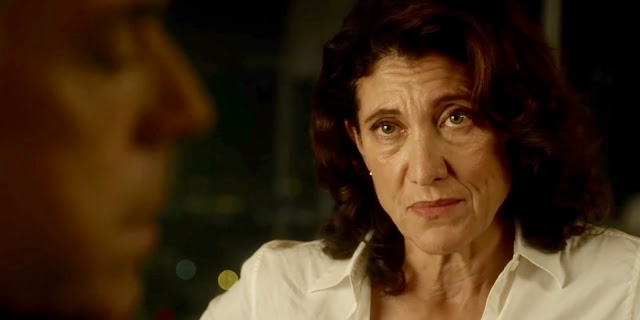“I don’t really care about the little guy. I just hate the big guy. I hate big smug people who think they can get away with things.” — Jack Reacher in “Persuader”
I’ve said it before and I’ll say it again... Lee Child doesn’t write the same book twice.
That’s what keeps his Jack Reacher series so fresh, interesting, and readable.
The past month I have been working to fill in the gaps and read all of Child’s novels. In that effort, I spent the past week reading his 2003 novel “Persuader.”
I only have three novels to go — 2004’s “The Enemy,” and Lee Child’s most recent efforts published in 2016 and 2017.
It’s going to feel unusual being all caught up. I love books — bookstores are deadly to my wallet — and I am in the midst of reading a number of series. I wanted to go into Lee Child’s April 11 appearance at UNO’s Baxter Arena ready, like a student who has carefully prepared for an examination. As such, I thought it’d be fun to have read all of his novels.
“Persuader” is one of Child’s most enjoyable Jack Reacher tomes. I’m kind of sorry I hadn’t read it earlier. The novel served up a heaping dose of action, clever twists, and an ample supply of “bad assery.”
“Persuader” starts off with a bang. On the opening pages of the novel, we find Jack Reacher on a college campus, next to a brown panel van parked outside a music store. He is about to kill a police officer with a Colt Anaconda — a huge, stainless steel revolver.
Reacher is the vigilante hero of 22 novels — a former military policeman who wanders the globe on his own time and dime.
To say the opening passages of “Persauder” are startling is an understatement. Not only does Reacher gun down the cop ("an accident," as he puts it), he thwarts the kidnap attempt of a college student named Richard Beck.
Before we know it, Reacher has eluded law enforcement, switched vehicles, and returned the boy to his familial home in Abbot, Maine — a stone mansion ensconced along the Atlantic Ocean.
But all is not as it seems, and we soon find out that Reacher is working for the DEA, attempting to infiltrate the Beck family compound, rescue another undercover operative (Teresa Daniel), and locate a “ghost” from his past (who appears to be doing business with Richard Beck’s father).
The “ghost” in question is a former military intelligence operative named Francis Quinn. Reacher is wandering the streets of Boston when he randomly runs into a man he believes to be Quinn — a man who had been shot in the head and presumed dead 10 years earlier.
Reacher starts dialing old phone numbers from his MP days and asks a Warrant Officer named Powell to run the man’s license plate for him. That move alerts the DEA — Agents Susan Duffy and Steven Eliot approach the unwary Reacher in Boston as he attempts another run-in with Quinn.
As the “knight errant” in Lee Child’s novels, Reacher is willing to help out the DEA. Reacher has an unquenchable thirst to learn about Lazarus rising from the dead. Quinn is presumed to be working with a Maine rug importer named Zachary Beck — and the feds don’t believe Beck is on the up-and-up.
“Persuader” is told using the first person narrative, and Child uses that structure to good effect as he ratchets up the suspense throughout the novel. Everything is told through Reacher’s point of view — the reader finds out when Reacher finds out.
As the novel progresses, there are two concurrent stories going on — the investigation of Zachary Beck’s business dealings in Maine, and “flashbacks” to an investigation of Francis Quinn during Reacher’s tenure as a military police officer.
While “Persauder” doesn’t tread any new ground for Lee Child, the pacing is brisk compared to the three preceding entries in the Jack Reacher series (“Running Blind,” “Echo Burning,” and “Without Fail”). It feels like a kindred spirt with the novels to follow.
Reacher also has more of an edge in this novel.
Reacher also has more of an edge in this novel.
A clever “Easter Egg” in the novel (if you want to call it that) is the title of the novel — “Persuader” — which is a clue in and of itself.
A quote that keeps coming up in “Persauder” is “bloody wars and dread diseases” — a phrase apparently uttered during toasts by the British Army in India during the Raj. It meant that a casualty further up the chain of command was the only way to get ahead.
The sentiment plays out in both the novel’s main storyline and flashback passages. To be sure, the events that play out in both threads are bloody and full of dread.
Child is a master at making the mundane feel compelling. “Persuader” illustrates once again why Jack Reacher — facing long odds — is one of the smartest sleuths in fiction today. He has the intellect of Sherlock Holmes mixed with the toughness of John McClane in “Die Hard.”
If you are interested, you might consider checking out Lee Child at UNO’s Baxter Arena on April 11. I’ve watched a number of interviews with the author on YouTube, including this event where he is “in conversation” with author Stephen King in Cambridge, MA:
Lee Child is fascinating to listen to, and tells a number of interesting tales about his life.
Click here to learn more about the event at UNO’s Baxter Arena on April 11 — the event is open to the public and tickets are free.
>> If you enjoyed my review of Lee Child’s “Persuader,” be sure to follow me on Twitter/X – @TheJonCrunch
Related posts on author Lee Child and Jack Reacher:
Previous post: Omaha World-Herald Lays Off 43... What's Happening?










































